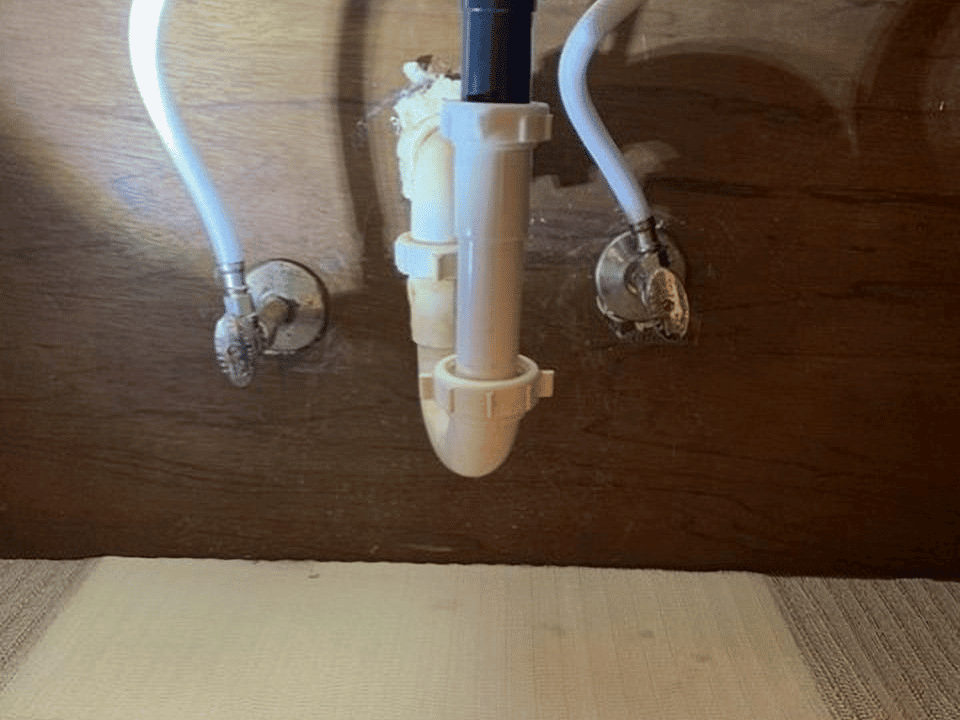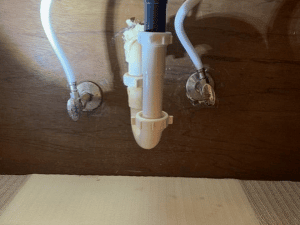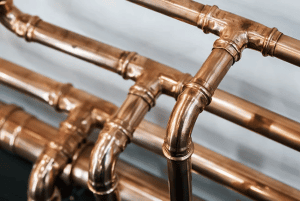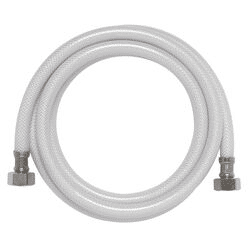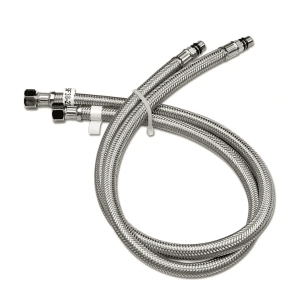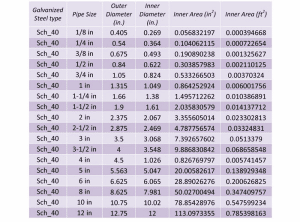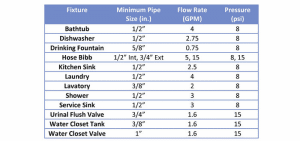Have you ever seen a faucet supply line (the lower supply line) and wondered what size it is? This is important as you might need to replace the supply line. Luckily this article will help you figure out the size of your faucet supply lines.
What is a Faucet Supply Line?
Image source: Ifixit
What It Is
A faucet supply line is a flexible tube that connects the water supply valve to the faucet. The length of each line varies depending on its location and use. The main function of a faucet supply line is to provide water to the faucet. The size also determines how much water can be used at any one time.
When installing a faucet, it’s important to choose a supply line that is long enough for your needs and fits snugly into place. You want to avoid having any gaps between the pipe and either end of the connection. If there are any gaps, air can get into the system and cause leaks or other problems with your plumbing system.
Are Faucet Supply Lines NPT?
NPT stands for National Pipe Taper. NPT is one of the most common types of fittings used in plumbing. The majority of supply lines that connect to faucets are made from copper or brass and have NPT threads. These supply lines typically use a compression fitting on the faucet end and a slip joint at the sink end.
The NPT threads are tapered and the diameter increases as you get closer to the end of the threaded section. This is important because it means that when you tighten your faucet supply lines, they will not leak.
Faucet Supply Line Types
Brass or Copper Supply Lines
Image source: Help Plumbing
Brass and copper are the most common materials used for plumbing supply lines. Both are durable, rigid, and easy to work with. However, they are also expensive compared with plastic or CPVC pipe.
Brass supply lines are more resistant to corrosion than their copper counterpart, which makes them ideal for areas with hard water and acidic water. They also offer resistance to heat. Copper supply lines are more flexible than brass fittings, making them easier to install on curved sink. They have better thermal conductivity than brass fittings.
Plastic or Vinyl Faucet Supply Lines
Image source: Ace Hardware
Plastic or vinyl faucet supply lines are the most common type of line. They are inexpensive and easy to install, but they do not last very long. They can become brittle over time and crack under pressure, which will cause water leaks.
They’re available in a wide range of colors, so you can match them to your bathroom decor. Plastic supply lines come in different diameters for different applications; larger diameter lines are more durable but also more expensive.
Vinyl faucet supply lines are more flexible and more pliable than plastic, which makes them easier to install. Vinyl is also less prone to breakage than plastic, especially when it’s bent repeatedly or twisted while in use. However, it’s not as durable as plastic.
Flexible Faucet Supply Lines
Image source: WayFair
Flexible faucet supply lines are the most common type of faucet supply lines. They are used for many types of faucets, including high-arc and low-arc models, as well as wall-mount, deck-mount, and bathtub spouts.
These flexible supply lines are made from stainless steel and feature a lifetime warranty. The design allows you to easily install your faucet in any location without the need for additional tools or modifications.
They are flexible and designed to be used with all types of faucets. These types of faucet supply lines come in several different sizes and lengths, so you can find one that fits your needs perfectly.
Does Size Really Matter with Standard Faucet Supply Lines
Standard faucet supply lines are one of the last steps in the plumbing process. They bring water from your plumbing system to your faucet. If you have a single-handle kitchen sink, the supply line is attached to the bottom of the spout. If you have a double-handle kitchen sink, it’s attached between both handles.
If you’re replacing an old supply line, make sure that you have enough length to reach from the wall to your faucet. Standard supply lines are usually about 5 feet long. You can buy longer ones if needed.
What Size is Faucet Supply Line
What Size Supply Line is Needed for a Kitchen Faucet
The size of the supply line is determined by the flow rate of the water coming into your home. The larger the flow rate, the larger diameter pipe you need.
The typical 3/8″ or ½” supply line is used for kitchen faucets that use 20 to 30 gallons per minute (gpm) or less. This includes most faucets that are 2-handle models with a single sprayer or one with two sprayers.
What Sizes are Bathroom Faucet Supply Lines
A typical bathroom sink faucet has a supply line that is 3/8″ diameter. The most common size for supply lines is 3/8″, but there are also 1/2″ and 5/8″ sizes. The size of the supply line should match the size of the faucet body. A larger faucet will require a larger supply line, and vice versa.
How to Measure Water Supply Line Size
Water Supply Line Size Chart
Image source: Engineering Guide
The size of the water supply line is important because it determines the flow rate of your home’s water system. If a pipe is too small, it can restrict the flow rate and cause problems; if a pipe is too large, it wastes money on unnecessary water pressure.
The following chart provides an overview of the most common sizes for residential homes in the United States. It should not be used as a reference for commercial buildings or commercial plumbing systems.
Standard Water Supply Line Size
Image source: Engineering Guide
The standard water supply line size is 1/2 inch. This should be used for most residential applications. If you are using a well or a private water source, the pipe size can vary depending on the source. A standard supply line size for this type of plumbing would be 3/4 inch.
A common issue that occurs with smaller lines is that they become blocked with sediment when they are not properly flushed out regularly. This causes issues with pressure loss, which can lead to leaks down the road if left untreated.
Are Kitchen Faucets Universal Size?
Kitchen faucets are not universal. Many people assume that the faucet will fit any sink, but this isn’t always the case. It’s important to make sure that you get the right faucet for your sink before you purchase it. In addition to ensuring that your kitchen faucet is the right size for your sink, there are other considerations that you should make as well.
What Size are Kitchen Faucet Connections
The connections that attach your faucet to the pipe it’s supposed to supply are called unions. They come in two basic varieties:
- Female unions (also called “females”) are used on pipes that have male threads (like a plumbing pipe), and
- Male unions (also called “males”) are used on pipes that have female threads (like a sink).
Common sizes for kitchen faucets include 1/2″ MPT (male) or 1/2″ FPT (female) threaded inlet.
Faucet Connector Sizes
Faucet connector sizes are standardized so that you can easily find the right size and type of faucet for your needs. The size of the faucet is indicated by the diameter of the threaded portion of the spout. Most faucets have a 1/2″ or 3/8″ diameter threaded spout, but there are other sizes available as well.
How to Determine Faucet Connection Size
The most common faucet connection size is 1/2 inch. This is the size that most faucets use, including bathroom sinks and kitchen sinks. You can determine which size your current faucet uses by checking the pipes that are connected to either end of the faucet. The pipes will have a 1/2-inch diameter, so if they’re different, then you’ll need to replace at least one of them with a new pipe that matches the new faucet’s connection size.
If you don’t know what size your current pipes are, then you can find this information in your home’s blueprints or construction plans. You can also contact your local building department and ask for assistance in determining what kind of fittings are used on your home’s plumbing system.
The most common type of faucet connection size is 1/2 inch, but there are also 3/4-inch and 1-inch sizes available. These sizes are typically used in commercial buildings or larger residential buildings where multiple fixtures need to be installed at once (such as multiple lavatories).
Bottom Line
The size of the piping being installed depends largely on the total amount of water your household will be using at any given time. This means that the answer to this question depends largely on your tap design, flow rate and gallons per minute (GPM) capacity.
